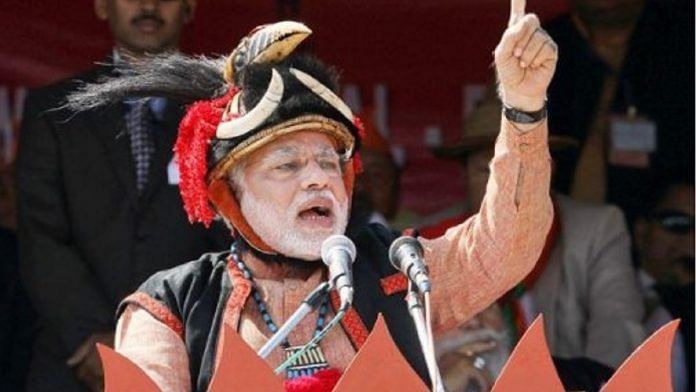Coming on the heels of Justin Trudeau’s Kissa Kurta Ka tour of India, Modi’s hats do raise some questions about when it’s a tribute to a culture and when it’s simply playing tourist-tourist.
“Take off your hat,” the King said to the Hatter.
“It isn’t mine,” said the Hatter.
“Stolen!” the King exclaimed, turning to the jury, who instantly made a memorandum of the fact.
“I keep them to sell,” the Hatter added as an explanation; “I’ve none of my own. I’m a hatter.”
– Lewis Carroll, Alice’s Adventures in Wonderland & Through the Looking Glass
Narendra Modi’s penchant for other people’s headgear has landed a foreign correspondent in India in a storm in a tea cup. Stanley Pignal of The Economist raised a lot of Twitter hackles by calling him the “most daring global leader” because of his appetite for wearing “outlandish headgear”.
Think horns, hornbill, peacock feathers. The Prime Minister has gamely donned them all (except for a skullcap of course) as have other prime ministers before him beginning with Jawaharlal Nehru.
Whatever anyone thinks of Narendra Modi, his appetite for wearing outlandish headgear is laudable. Hands down the most daring global leader in this respect. pic.twitter.com/AVqNNFAmm0
— Stanley Pignal (@spignal) February 28, 2018
Sensible people can choose to disagree about whether a hat can sometimes be indeed over the top.
It’s the word “outlandish” that has stuck in people’s craws. Writer Amish Tripathi told Pignal “I never speak on politics. But your comment borders on bigotry. This is not outlandish headgear. They are what many communities in India wear.”
BJP MP Maheish Girri advised Pignal, “Shed your elitism and understand the country you cover slightly better.”
Pignal responded by dismissing the “synthetic outrage” and saying “you have to start by arguing a *hat with a bird in it* is in no way outlandish, which some people might find difficult.” And to be fair, he said kilts and bearskin hats are pretty “outlandish” as well.
It’s easy to bristle at the word “outlandish” especially when it comes from a foreign correspondent about headgear that belongs to India, whether or not it comes with a hornbill on it. After all the Merriam Webster dictionary defines “outlandish” as “of or relating to another country” even if Pignal probably meant “strikingly out of the ordinary: Bizarre”.
But coming on the heels of Justin Trudeau’s Kissa Kurta Ka tour of India, it does raise some intriguing questions about when it’s a doff of the hat to a particular culture and when it’s simply playing tourist-tourist.
When the Trudeaus emerged like a sort of Family Von Trapp Goes to Manyavar, it was cute. The first time. After the never-ending blingy costume changes, it quickly felt more like a preening clotheshorse than a multiculturally woke PM. It was clearly more about dressing up for the cameras than paying tribute to any cultural diversity. That in the end was Trudeau’s wardrobe malfunction.
It’s silly to ascribe high-minded noble motives to what is ultimately just another photo-op. Once we could say politicians were being sporting if they allowed themselves to look a little ridiculous, stepping out of their comfort zone – trying to do a Bhangra move, speak some broken Hindi, or wear a sari albeit uneasily.
But politicians like Modi and Trudeau are so media-savvy, so image-conscious, so choreographed that it’s hard to imagine they would ever knowingly risk appearing vulnerable or awkward. Yet, sometimes we do look awkward.
The king of Bhutan carries off those skirts with dashing ease because he was born to it. The rest of us would look very gauche and self-conscious. And that includes Narendra Modi if he tried it. He once did push his own sartorial boundaries when he appeared in traditional Ladakhi wear. On young people in Leh, it looked fine. Modi looked like a portly man in a golden dressing gown with a grand vizier hat perched on top of his head. One could only wonder what was going on in then-CM Omar Abdullah’s head when confronted with that vision.
While the outrage over “outlandish” is understandable, we can’t get too hot under the collar about this kind of exoticizing of our traditional outfits when NRI parents happily think kurtas and ghagra-choli are acceptable “fancy dress” for a Halloween party in New Jersey. And let’s not pretend that a political leader who descends on Kohima, puts on Naga tribal gear, suddenly understands local sensitivities better via a hat. There are many ways to respect cultural diversity, to promote it, to celebrate it. Wearing a hat from someone else’s culture is pretty low down on that list. Wearing a local hat does not suddenly make you feel the pain of AFSPA.
Many are lambasting Pignal for apparently not getting that the Northeast is part of India, and its headgear, however bizarre it looks to him, is part of India’s cultural diversity. It’s heartening to see so many on Twitter rising to defend the honour of the northeast’s headgear. It would be even more heartening if even more would rise to defend the honour of those who live in the northeast instead of demanding to see their passports at the Delhi Airport, calling them “chinky” and “chilli chicken”, and even lynching them when they protest racist taunts.
All the northeastern headgear that India’s PMs have worn, from Nehru to Modi, have not sensitised their countrymen enough to protect actual northeasterners from being treated as “outlandish” in cities like Delhi and Bengaluru.
And as far as Modi goes, we should probably pay more attention to his Hedgewar moments than his headgear moments. The former, as founder of the RSS, will have a far more lasting impact on Modi’s vision for India than the latter.
Sandip Roy is a journalist, commentator and author.



